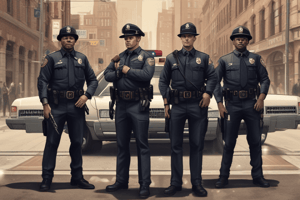Podcast
Questions and Answers
What did the union report state about the equipment provided during the riots?
What did the union report state about the equipment provided during the riots?
- It was adequate and well-suited for handling the situation
- It was ill-fitting, mismatched, expired, faulty, or only for training purposes (correct)
- It was unnecessary for the situation
- It was modern and effective in preventing injuries to officers
What did the After Action Review (2015) claim about the department’s leadership during the riots?
What did the After Action Review (2015) claim about the department’s leadership during the riots?
- It was well-prepared, attentive, and decisive, and not politically influenced
- It was negligent and indifferent towards the officers' safety
- It was supportive, organized, and strategic in its approach
- It was unprepared, uncaring and confused, and politically motivated (correct)
What was the primary tactic used by the police during the riot according to the After Action Review (2015)?
What was the primary tactic used by the police during the riot according to the After Action Review (2015)?
- "Negotiate with the rioters to reach a peaceful resolution"
- "Aggressively confront and disperse the rioters"
- "Hold the line" without intervening or engaging the rioters (correct)
- "Retreat and regroup to form a new strategy"
What were officers told regarding intervention or engagement with the rioters?
What were officers told regarding intervention or engagement with the rioters?
What percentage of BPD officers in 2015 were African American?
What percentage of BPD officers in 2015 were African American?
What percentage of BPD stops from January 2010 to June 2015 were of African Americans?
What percentage of BPD stops from January 2010 to June 2015 were of African Americans?
What was the percentage of drug arrests for African Americans per 1,000 residents in Baltimore from 2010 to 2012 compared to other comparable cities?
What was the percentage of drug arrests for African Americans per 1,000 residents in Baltimore from 2010 to 2012 compared to other comparable cities?
What did the U.S. Department of Justice conclude about the BPD's actions?
What did the U.S. Department of Justice conclude about the BPD's actions?
What was one of the reasons for Baltimore police being ill-prepared for the 2015 riots?
What was one of the reasons for Baltimore police being ill-prepared for the 2015 riots?
What was a consequence of the miscommunications during the 2015 riots?
What was a consequence of the miscommunications during the 2015 riots?
What contributed to the shortage of patrol officers during the 2015 riots?
What contributed to the shortage of patrol officers during the 2015 riots?
Why did Baltimore police lack personal protection equipment for mass demonstrations or riots?
Why did Baltimore police lack personal protection equipment for mass demonstrations or riots?
What did an expert feel was lacking during the riot?
What did an expert feel was lacking during the riot?
What was a concern raised by the officers during the riot?
What was a concern raised by the officers during the riot?
What did the U.S. Army Civil Disturbance Operations manual recommend for officer formation?
What did the U.S. Army Civil Disturbance Operations manual recommend for officer formation?
What was a reported issue with the distributed shields?
What was a reported issue with the distributed shields?
What was Commander Arnold's opinion on the decision-making process during the riots?
What was Commander Arnold's opinion on the decision-making process during the riots?
What did Commander Arnold say about the police's response to criminal behavior near the stadium district?
What did Commander Arnold say about the police's response to criminal behavior near the stadium district?
According to Commander Arnold, why did some commanders feel they were not supposed to engage rioters?
According to Commander Arnold, why did some commanders feel they were not supposed to engage rioters?
What was the key criticism of the Baltimore City Police Department (BPD) in the report by investigators for the Civil Rights Division of the U.S. Department of Justice?
What was the key criticism of the Baltimore City Police Department (BPD) in the report by investigators for the Civil Rights Division of the U.S. Department of Justice?
Flashcards are hidden until you start studying
Study Notes
- On April 27, 2015, students at the Mondawmin Mall in Baltimore began throwing bottles and bricks at the police, which escalated into violence and looting for several hours.
- By 4:30 p.m., the crowd was setting fires and moving downtown, and the police were unable to stop them.
- Police commissioner gave conflicting statements about giving orders to advance or hold the line.
- An expert felt that there should have been more officers present to make arrests and control the crowd.
- Commissioner Batts ordered 215-300 officers to control the crowd, but it was insufficient.
- There were no plans in place to call in extra officers from nearby districts or use less-lethal weapons or extraction teams.
- The U.S. Army Civil Disturbance Operations manual recommends a multi-layered formation of officers, including a front line, a second line, less-lethal weapons teams, and extraction teams.
- During the riot's first 24 hours, the number of officers available was inadequate to implement such a formation.
- Officers complained about a lack of protective equipment, such as shields, helmets, and body armor, which hindered their ability to control the situation.
- Protective equipment was not distributed until two days after the worst rioting had occurred.
- Officers reported that their shields were flimsy, and one officer was injured when a rock penetrated his helmet visor.
- A full protective suit and helmet cost about $800, while a shield cost about $175.
- Officers questioned whether Commissioner Batts had dropped the ball or if it was a budgeting issue.
Studying That Suits You
Use AI to generate personalized quizzes and flashcards to suit your learning preferences.




